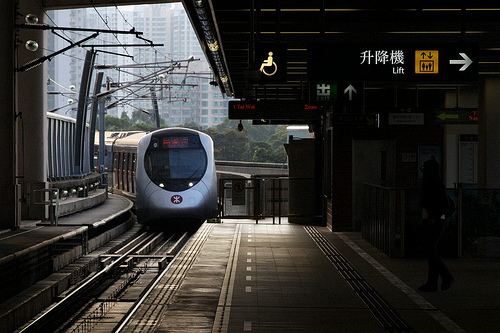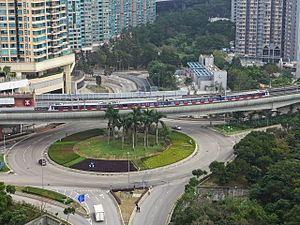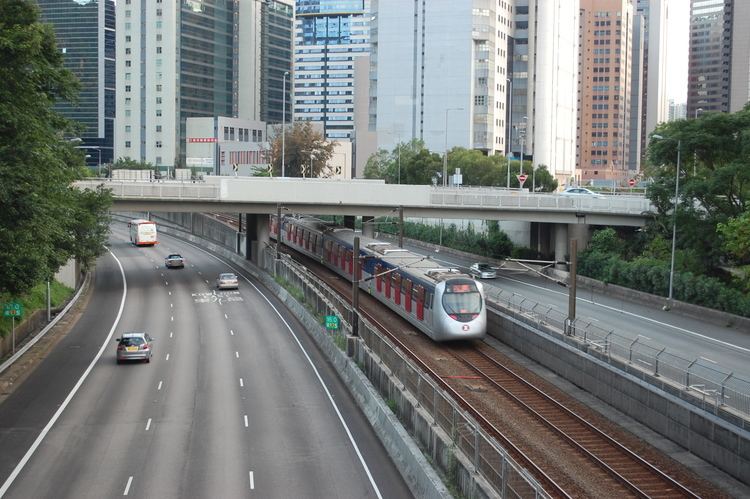Type Rapid transit Opened 21 December 2004 Stations 9 | System MTR Depot(s) Tai Wai | |
 | ||
Ridership 153,100 weekday average
(Sept to Oct 2014) Rolling stock SP1900/1950 EMU
East West Line C-train Locale Sha Tin District (Districts) Terminis Tai Wai Station, Wu Kai Sha Station | ||
2016 mtr ma on shan line new train car arrangement cm hd
The Ma On Shan Line (Chinese: 馬鞍山綫) is a branch line of the MTR East Rail Line in Hong Kong. It is coloured brown on the MTR map. Before 2 December 2007, the railway was operated by the Kowloon-Canton Railway Corporation (KCRC) as Ma On Shan Rail (Chinese: 馬鞍山鐵路, abbreviated as 馬鐵). Since the KCRC's merger of operations with the MTR Corporation, the line has been one of the ten lines of the MTR.
Contents
- 2016 mtr ma on shan line new train car arrangement cm hd
- Mass transit railway hd ma on shan line sp1950 train city one station 5 16 15
- Overview
- Driving directionality
- Rolling stock
- Stations
- Future development
- References

Mass transit railway hd ma on shan line sp1950 train city one station 5 16 15
Overview

KCRC estimated the construction cost of Ma On Shan Rail would be HK$10 billion. The line starts at Tai Wai station in Tai Wai, Shatin and ends at Wu Kai Sha Station, Wu Kai Sha, totalling 11.4 km or 16 minutes of journey time. It has nine stations, with a maintenance depot at Tai Wai. Construction began on 12 February 2001 and the line opened on 21 December 2004, 3 days earlier than the proposed opening date. From its opening as part of the KCR system, the interchange with the East Rail at Tai Wai has not had ticket gates between the Ma On Shan Rail and East Rail platforms, unlike at the former KCR system's interchanges with the MTR system. A trip from either line to the other counted as one ride.

Most of the line, including stations, was built on a viaduct on land which had been reserved for the purpose of a railway from the outset of the development of Ma On Shan New Town.

In June 2016, using the ubiquitous Octopus stored-value card, the fare for a trip on the line ranged from HK$3.7 to HK$5.3 depending on the distance travelled. The fare from Ma On Shan to East Rail Line stations in Kowloon ranged from HK$5.3 to HK$10.2.

Over a thousand passengers went to Tai Wai to take the first train on the first day of service. However, just an hour after service commenced, one train suffered minor door defects, causing a three-minute delay. After the opening of the Ma On Shan Line, the usage of buses and taxis in the area decreased by as much as 50%. It was reported that some bus routes operated by KMB saw a decrease of ridership by one-third just a few days after the railway opened.
Driving directionality

Road and rail traffic in Hong Kong move on the left, but Ma On Shan Line is an exception. This line is aligned to the east of East Rail Line, and the two southbound tracks are immediately next to each other at their connection in Tai Wai. This design is to speed up passenger interchange to the East Rail Line to Kowloon during the morning commute. Therefore, the Ma On Shan Line moves on the right.
Rolling stock
Although the Ma On Shan Line is, in the Hong Kong context, classified as a "medium-capacity system", it is capable of passenger volumes up to 32,000 passengers per hour per direction (PPHPD), which is comparable to the passenger capacity of a full rapid transit or "metro" system.
KCRC initially ordered 18 sets of Kinki Sharyo EMU SP1950 trains, built by Kinki Sharyo, which have run in a four-car configuration since the line commenced service. The train is the same model as the one used on the high capacity East Rail Line and West Rail Line, which runs on those lines with twelve-car and seven-car/eight-car configurations respectively. In March 2017, two 8-car sets of the East West Line Train, manufactured by CRRC Changchun, entered service on the line. These models have a maximum running speed of 130 km/h (81 mph) and 160 km/h (99 mph) respectively, but trains only reach a maximum service speed of 100 km/h (62 mph), when travelling between Shek Mun and Tai Shui Hang stations on at-grade track between the carriageways of Tate's Cairn Highway, and 75 km/h (47 mph) between other stations. Trains on the line are serviced at Tai Wai Depot.
Two sets of 8-car trains were introduced on 15 January 2017 as part of works for the Sha Tin to Central Link. Passengers have to pay attention to the platform LCD screens and announcements to queue at the right part of the platforms.
The first two of 14 new trains, ordered by MTR, made by CRRC Changchun, entered service in March 2017.
Stations
The following is a list of the stations on the Ma On Shan Line.
Future development
Since the early planning stages of the Ma On Shan Line, the system has been designed to be capable of joining with the West Rail Line. According to the latest modified proposal of the Sha Tin to Central Link, the Ma On Shan Line will be extended from Tai Wai Station to Hung Hom Station via East Kowloon. The extension will connect to the West Rail Line at Hung Hom and continue on to the northwest New Territories. Eight-car trains will run on the conjoined line, and so the platforms of the Ma On Shan Line were lengthened from 2014 to 2016. Eight-car trains began running on the line on 15 January 2017. Automatic platform gates are currently being retrofitted on all stations on the line with a target completion date of 2017.
